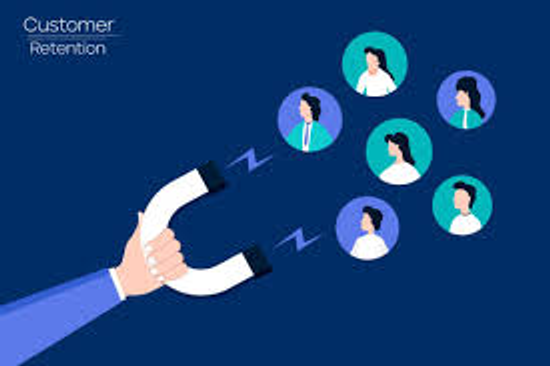How to improve customer retention and loyalty with emotional AI?
Published on September 25, 2024 - Updated on October 02, 2024
How to improve customer retention and build loyalty with Emotional AI
In an increasingly competitive market, building customer loyalty is essential to ensure the long-term future of your business. But how can you improve your customer retention rate and turn your users into loyal customers? In this article, we reveal the key strategies for boosting customer retention, while focusing on the importance of Emotional AI, a technology that Q°emotion uses to enhance the customer experience. Find out how to deliver rapid and continuous value, while boosting satisfaction and loyalty.
What is customer retention?

Before diving into retention strategies, it's important to define what retention rate is. The customer retention rate represents a company's ability to keep its customers over a given period. It is opposed to the churn rate, which quantifies the number of customers lost. A high retention rate is often the sign of a successful customer experience and a product/service that meets expectations.
Here's a simple formula for calculating the retention rate:
Customer retention rate (%) = ((Number of customers at the end of the period - Number of new customers acquired during the period) / Number of customers at the beginning of the period) x 100
Why is the retention rate so crucial?
1. Reducing acquisition costs
It's a well-known fact that acquiring a new customer costs on average five times more than retaining an existing one. By increasing your retention rate, you reduce your acquisition costs and maximise the value of each customer over time. Loyalty pays.
2. Increasing customer lifetime value (CLV)
The retention rate has a direct impact on Customer Lifetime Value (CLV). The longer a customer remains loyal, the more they spend over time, which contributes to the company's long-term profitability. According to some studies, an increase of just 5% in the retention rate can lead to an increase in profits of between 25% and 95%.
3. Improved company reputation
Loyal customers are often your best ambassadors. Not only do they come back, but they also tell their friends and family about you, share their experience on social networks and can generate positive word-of-mouth. A high retention rate is often synonymous with customer satisfaction and can greatly enhance your brand's reputation.
4. Customer satisfaction indicator
A good retention rate is generally a sign that your customers are satisfied with your products or services. It can also reflect the quality of the customer experience you offer. On the other hand, a low retention rate can be an early indicator of problems, whether in product quality, customer support or the buying journey.
The 6 Time-to-Value (TTV) steps for improving customer retention

The concept of Time-to-Value (TTV) is central to customer loyalty. It represents the time it takes for a customer to perceive the value of a product or service after their purchase. The shorter this time, the more satisfied and loyal the customer will feel. Here are the six stages of TTV and how to optimise them to improve your retention rate.
1) Time-to-first-value: Generate a Rapid First Value
Time-to-First-Value (TTFV) refers to the period between customer acquisition and the moment when the customer obtains the first tangible value from your product or service. Reducing this time is crucial to improving customer satisfaction and increasing the likelihood of customer loyalty. By providing initial value quickly, companies create a positive impact from the very first days, encouraging long-term commitment. Reducing Time-to-First-Value not only helps build customer trust, but also maximises Customer Lifetime Value (CLV) over the long term. The first 24 to 48 hours after purchase are critical. Customers are wondering whether they've made the right choice. Offer them an immediate sample of the value you promise. For example, here's an action plan you can propose to your customers if you have a SaaS solution:
Actions to implement:
- Offer fast, seamless onboarding
- Monitor the customer's first steps with proactive support
- Provide tutorials or simple start-up guides
- Send a personalised welcome email
Key metrics to track:
- Average time to deliver first value
- Initial engagement rate
2) Time-to-reliable-value: ensuring continuous, reliable value
Time-to-Reliable-Value (TTRV) represents the time it takes for a customer to perceive reliable and lasting value from your product or service. Unlike Time-to-First-Value, which focuses on the initial impact, TTRV aims to ensure that this value endures over time, thereby reinforcing customer confidence and satisfaction. To optimise Time-to-Reliable-Value, it is crucial to offer a stable service, regular updates and high-quality technical support. By providing continuous, reliable value, you encourage long-term loyalty and improve Customer Lifetime Value (CLV), which directly boosts your company's profitability. You need to ensure that your solution consistently delivers the promised value, without interruption.
Actions to implement :
- Monitor the user experience using analytics tools
- Adapt your offering based on customer feedback
- Plan regular communications to maintain engagement
Key metrics to monitor :
- Satisfaction rate
- Rate of repeat use
3) Time-to-exhaustive-value: delivering full value
Time-to-Exhaustive-Value (TTEV) refers to the time it takes for your customers to access all the features and benefits offered by your product or service. This is the final stage in the customer journey, where exhaustive value is fully realised, enabling customers to get the most out of your solution. Reducing TTEV involves providing in-depth support, comprehensive tutorials and rapid access to advanced functionality. Ensuring that users exploit the full potential of your offering not only enhances customer satisfaction, but also promotes retention and increases Customer Lifetime Value (CLV). Delivering full value quickly is essential to ensure long-term commitment. Here, two approaches are effective: deliver early or provide extra value.
Actions to take:
- Monitor delivery progress closely
- Ensure consistent high quality
- Communicate proactively on the progress of key stages
Key metrics to track:
- Average delivery time
- Ratio of promised lead time to actual lead time
4) Time-to-reordering-value: encouraging repeat purchases
Time-to-reordering-value (TTRV) refers to the time between a customer's initial purchase and the moment when they make a new purchase. Reducing this time is crucial to increasing purchase frequency and maximising customer lifetime value (CLV). Encouraging repeat purchases involves strategies such as personalising recommendations, sending targeted offers and setting up loyalty programmes. The shorter the TTRV , the more committed customers are and the more likely they are to become regular buyers. By optimising this timeframe, you can strengthen customer loyalty, boost revenues and improve your company's overall profitability. Once a customer has seen the value of your product, it's time to encourage them to recommend or buy again, whether through upselling or cross-selling. The quicker a customer reorders, the more likely they are to remain loyal.
Actions to implement:
- Propose related or improved offers
- Create loyalty programmes to encourage repeat purchases
- Use data analysis to target customers who are most likely to recommend a product.
Key metrics to track :
- Re-purchase rate
- Customer loyalty rate
5) Time-to-promoting-value: turning your customers into ambassadors
Time-to-promoting-value (TTPV) measures the time it takes for a customer to become an active ambassador for your brand, sharing their positive experience and recommending it to others. By reducing this time, you can maximise word-of-mouth and organic promotion. To accelerate TTPV, it is crucial to offer an exceptional customer experience, solicit reviews, and set up referral programmes or rewards for referrals. A short Time-to-Promoting-Value can quickly turn your satisfied customers into true ambassadors, generating greater awareness and strengthening long-term loyalty. A loyal customer who recommends your product is the best form of advertising. Actively encourage recommendations by rewarding those who tell others about your brand.
Actions to take :
- Encourage positive reviews and recommendations
- Set up a referral programme
- Collect testimonials and case studies to share
Key metrics to track :
- % of customers who have recommended your product
- Number of new customers acquired by recommendation
The power of emotional AI to improve customer retention

Emotional and semantic AI is revolutionising the way companies understand and interact with their customers, by providing deep insights into their emotions and feelings. By analysing customer feedback, comments and interactions through advanced AI technologies such as Q°emotion, companies can identify frustrations, needs and unexpressed expectations. With this fine-grained understanding of emotions, it's possible to personalise the customer experience, proactively solve problems and create more engaging communications. As a result,emotional AI not only boosts customer satisfaction, but also significantly increases retention rates, turning one-off customers into loyal brand ambassadors. Using AI to anticipate and respond to customer emotions is therefore becoming a strategic lever for building long-term loyalty. At Q°emotion, we use emotional AI technology to help companies understand and improve their customers' emotional experience.
Some examples of applications:
- Identify moments of doubt or dissatisfaction in the verbatims left by customers and take immediate action
- Personalise the customer experience according to prevailing emotions
- Offer content, services or products tailored to the emotional feelings of each customer segment
Optimise retention rates with emotional AI
Emotional AI is a strategic lever for optimising every stage of the Time-to-Value process and improving customer retention. By understanding your customers' emotions through advanced semantic analysis, you can anticipate their needs and respond proactively to their expectations. By identifying emotional signals, AI can reinforce the positive moments in the customer journey while reducing the risk of dissatisfaction. This approach accelerates value creation at every stage, while creating a deeper connection with your customers. The result: improved customer retention, as users feel better understood and more engaged with the brand.
Conclusion: boost your retention rate for sustainable growth
Time is a crucial factor in customer loyalty. The faster you deliver value, the more satisfied your customers will feel and the more likely they will be to repeat the experience. By applying Time-to-Value strategies and leveraging emotional data with AI, you maximise your chances of improving customer retention. Retention is a mix of immediate satisfaction and lasting emotional commitment.
Similar posts
Customer Experience vs. Customer Success: Understanding the differences and maximising customer loyalty through emotional analysis
Published on October 29, 2024 - Updated on November 04, 2024
In an increasingly competitive business environment, companies must now redouble their efforts to capture and retain customers. According to a recent study by Forrester , 73% of companies now...
Reduce holiday stress with Q°emotion: How brands can manage customer emotions over Christmas
Published on October 29, 2024 - Updated on February 14, 2025
Reduce holiday stress with Q°emotion: How brands can manage customer emotions over Christmas Introduction: The Christmas paradox Although Christmas is traditionally a time of joy, sharing and celeb...